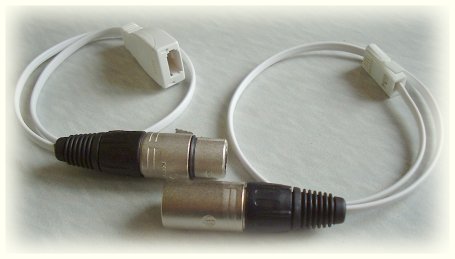

Note
This telephone interface is no longer available and info is supplied for support purposes only.General
This telephone interface allows two phones to be practical and have communication with each other and also provides an isolated audio output which is the sum of the signals from each telephone. It can also be used in a single phone mode when drama is being shot in a single camera fashion though the phone still has side-tone in the earpiece and a fully isolated transformer coupled audio output is available for recording.
Power input is from any convenient 12 to 15 volt DC supply and is connected through an XLR4 connector, wired as often used on other portable broadcast equipment. The unit is designed to provide the maximum reliability in location recording and filming conditions with features such as rugged Neutrik audio and power connectors and a second fuse holder to carry a spare fuse.
Telephones with normal BT style plugs can be connected directly to the interface but readily available extension cables fitted with BT 431A connectors can also be used to extend one or both circuits up to several hundred metres. As phone-ring sound effects are often more conveniently added during post production, this interface has no ringing current generator, though alternative versions that provide ringing current have also been developed.
An unconventional use can allow the interface to inject audio signals into one or two connected telephones in a fully isolated manner by applying a line level signal into the XLR3 connector.
Power input
Even with the lamp lit and a phone off-hook, the current drain is extremely modest and an NP1 will provide tens of hours of operation. With a 12 volt supply, current consumption with two telephones off-hook is 25mA. When either or both handsets are "hung-up" no current is drawn. Current consumption with the indicator lit, and one phone off-hook is 45mA and when that phone is replaced, drops to just 13.6mA for the warning indicator. Supply voltages up to 15 volts can safely be used and in single phone mode, the system can operate with supplies as low as 8 volts, though many phone types may not work reliably with such low voltages.
Phone types
Most types of telephone that can be connected directly to BT analogue circuits can be used. The interface has been tested with modern types having dynamic microphone inserts and also the older carbon microphones. Even hybrid arrangements with one phone of each type can be used successfully, though it should be remembered that the audio quality from carbon microphones is significantly worse than that from newer types. The audio output level depends on the type of telephone and the voice level used but connecting the phone interface to a line input with a gain of 10dB will typically produce normal progamme level signals. The output can be connected to phantom powered mic inputs if they are capable of handling the fairly high signal level but should not be used with T power inputs.
It must be stressed that this interface is not approved for connection to the BT or any other telephone network and doing so may cause unpredictable results in that telephone system, though it might sometimes provide an isolated audio signal from the system.
Adapter Cables

Telephones can be connected directly to the box or standard BT type telephone extender cables can be added. The type of cable often used with the extenders often sold in DIY stores is not always be ideal for location filming as it does not lay well across studio floors. A pair of adapter cables is available which converts the BT connections to allow standard XLR3 microphone type cables to be used as extenders. These adapter cables DO NOT allow audio to pass between telephone systems and conventional balanced line audio equipment. It is essential that XLR3 cables being used for telephone purposes are not connected to conventional audio circuits and PHM accepts no liability for the damage to telephones, interfaces or other equipment which could easily be caused if such a connection is made!
Connector sex
The adapter with the BT female connector that receives the plug of the telephone instrument is wired to an XLR3 female connector. This means that cables run out for telephone purposes have the male and female ends the opposite way round to any cables running onto the set for microphone purposes. Particular care is needed if cabled talkback or playback speaker feeds are run onto the set as the XLR sexing of the phone cable may be the same as these.
Handling
Although the XLR3 connectors and the wiring to them is made to robust professional standards, the moulded plastic BT style connectors are relatively fragile and should not be placed where they may be subject to stress such as being walked on!
Availability
These units were built to order, allowing a high degree of flexiblity but they are no longer available. Payment for other custom projects can be by UK cheque or Visa/Mastercard. For further details of price, delivery and alternative versions, contact Melanie Harrison at the address below.
All material is copyright PHM © 2010
P H M (P H Music) : Ramsbottom
Lancashire : GB
tel: +44 (0)7799 621954
email: info@phmusic.co.uk